The counting of ballots in the closely watched unionization drive at the Amazon warehouse in Bessemer, Ala., is set to resume Friday at 8:30 a.m. Central time.
With about half the ballots counted late Thursday, votes against unionization had an advantage of more than 2-to-1 over those in favor, according to a live broadcast of the counting that was tallied by The New York Times. When the counting paused, there were 1,100 votes against unionization and 463 in support.
There were 3,215 ballots cast, according to the Retail, Wholesale and Department Store Union, from 55 percent of the 5,805 eligible voters at the warehouse. The union must get support from more than half of the votes cast to prevail.
Unofficial Tally of Amazon Warehouse Unionization Votes
1,608 yes votes are needed for the union to win today.
The New York Times·As of 9:25 a.m. Hundreds of ballots have been contested, which could delay either side from reaching the threshold. One ballot was marked as void.
The ballots were being counted in random order in the National Labor Relations Board’s office in Birmingham, Ala., and the process was broadcast via Zoom to more than 200 journalists, lawyers and other observers.
The voting was conducted by mail from early February until the end of last month. A handful of workers from the labor board called out the results of each vote “Yes” for a union or “No” for nearly four hours on Thursday.
Amazon and the union had spent more than a week in closed sessions, reviewing the eligibility of each ballot cast with the labor board, the federal agency that conducts union elections. The union said several hundred ballots had been contested, largely by Amazon, and those ballots were set aside to be adjudicated and counted only if they were vital to determining an outcome. If Amazon’s large margin holds steady throughout the count, the contested ballots are likely to be moot.
The incomplete tally put Amazon on the cusp of defeating the most serious organized-labor threat in the company’s history. Running a prominent campaign since the fall, the Retail, Wholesale and Department Store Union aimed to establish the first union at an Amazon warehouse in the United States. The result will have major implications not only for Amazon but also for organized labor and its allies.
Labor organizers have tapped into dissatisfaction with working conditions in the warehouse, saying Amazon’s pursuit of efficiency and profits makes the conditions harsh for workers. The company counters that its starting wage of $15 an hour exceeds what other employers in the area pay, and it has urged workers to vote against unionizing.
Amazon has always fought against unionizing by its workers. But the vote in Alabama comes at a perilous moment for the company. Lawmakers and regulators — not competitors — are some of its greatest threats, and it has spent significant time and money trying to keep the government away from its business.
The union drive has had the retailer doing a political balancing act: staying on the good side of Washington’s Democratic leaders while squashing an organizing effort that President Biden has signaled he supported.
Labor leaders and liberal Democrats have seized on the union drive, saying it shows how Amazon is not as friendly to workers as the company says it is. Some of the company’s critics are also using its resistance to the union push to argue that Amazon should not be trusted on other issues, like climate change and the federal minimum wage.
Sophia June contributed to this report.

Boeing said Friday it had notified 16 customers of a potential electrical issue with its troubled 737 Max plane and recommended that they temporarily stop flying some planes.
Boeing said airlines should verify that “that a sufficient ground path exists for a component of the electrical power system” on certain Max planes. The statement comes just months after airlines resumed flying the jet, which had been grounded for nearly two years because of a pair of accidents that killed nearly 350 people.
“We are working closely with the U.S. Federal Aviation Administration on this production issue,” Boeing said in a statement. “We are also informing our customers of specific tail numbers affected and we will provide direction on appropriate corrective actions.”
Southwest Airlines, one of the biggest customers of the plane, said that 30 of its 58 Max jets were affected by the notification and that it was swapping those planes out for now. The airline is only flying 15 or fewer Max jets each day.
“Southwest anticipates minimal disruption to our operation, and we appreciate the understanding of our customers and employees as safety is always our uncompromising priority,” it said in a statement.
The Max was banned from flying globally in March 2019 after the crashes. After a lengthy review, the F.A.A. allowed the Max to fly again in November, provided that Boeing and airlines make required changes to the jet, including updating its flight control software.
Since then, aviation regulators around the world have followed suit and the plane has been used on thousands of flights.
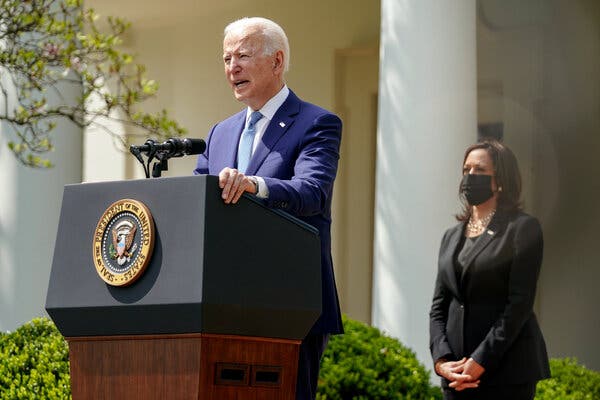
The White House budget office will release the first fragments of President Biden’s budget proposals to Congress on Friday, providing a fresh sense of his priorities as lawmakers wait on his administration’s full budget.
Officials have stressed that the document — which will outline plans for discretionary spending within government agencies — is not a formal budget and will not include tax proposals or so-called mandatory spending in areas like Social Security. Instead, it will provide overall funding levels for agencies, like the Treasury and Defense Department, and some detail on proposed spending across the administration in areas like combating climate change.
The request will cover the 2022 fiscal year, which starts in October. White House officials had originally announced it would be released last week, before pushing back the timeline. The budget office does not have a confirmed director, after Mr. Biden’s first pick for the job, Neera Tanden, withdrew from consideration amid Republican opposition centered on her past statements on Twitter that were critical of conservatives.
Shalanda D. Young, who was confirmed by the Senate last month to be deputy director of the Office of Management and Budget, is serving as Mr. Biden’s acting budget director.
Officials have promised that Mr. Biden’s full budget will be released later this spring. They have blamed delays on a lack of cooperation from outgoing members of the Trump administration.
“Well there’s no question, as we talked about during the transition, that we dealt with some impactful intransigence from the outgoing political appointees,” Jen Psaki, the White House press secretary, told reporters this week.
“We had some cooperation from the career staff, but we didn’t have all of the information that we needed,” she added. “As you all know, we also don’t have a budget director. We have not had a budget director confirmed. We have now an acting budget director, which is an important step forward.”
Congress, which is responsible for approving government spending, is under no requirement to adhere to the White House budget, which is generally viewed as a political messaging document. In recent years, lawmakers rejected many of the Trump administration’s efforts to gut domestic programs.
Officials say the proposal that will be released on Friday will not reflect the details in Mr. Biden’s $2.3 trillion infrastructure plan, which he introduced last week, or of a second plan he has yet to roll out, which will focus on what officials call “human infrastructure” like education and child care.
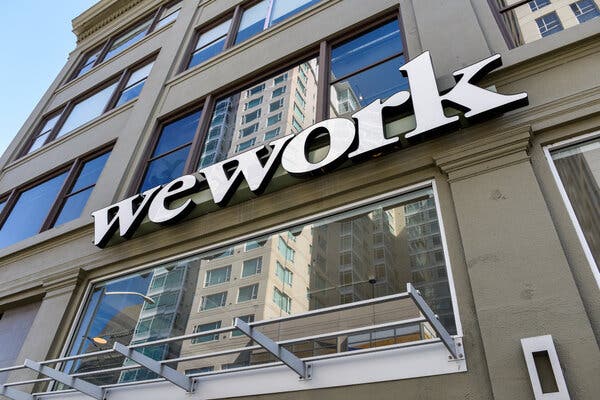
After weeks of wading into the debate over how to regulate SPACS, the popular blank-check deals that provide companies a back door to public markets, the Securities and Exchange Commission is sending its first shot across the bow.
John Coates, the acting director of the corporate finance division at the S.E.C., issued a lengthy statement on Thursday about how securities laws apply to blank-check firms, the DealBook newsletter reports.
In particular, he is interested in a crucial (and controversial) difference between SPACs and traditional initial public offerings: blank-check firms are allowed to publish often-rosy financial forecasts when merging with an acquisition target, while companies going public in an I.P.O. are not.
“With the unprecedented surge has come unprecedented scrutiny,” Mr. Coates wrote of the recent boom in blank-check deals.
Investors raise money for SPACs via an I.P.O. of a shell company, and those funds are used to merge with an unspecified company within two years, which then also becomes a publicly traded company. Because the deal is technically a merger, it’s given the same “safe harbor” legal protections for its financial forecasts as a typical M.& A. deal.
With traditional I.P.O.s, companies can’t issue such projections to prospective investors, because regulators consider it too risky for firms as yet untested by the public markets. And that’s why there are flying-taxi companies with little revenue going public via a SPAC while promising billions in sales far in the future.
The S.E.C. thinks allowing financial forecasts for these deals might be a problem. They can be “untested, speculative, misleading or even fraudulent,” Mr. Coates wrote. And he concludes his statement by suggesting a major rethink of how the “full panoply” of securities laws applies to SPACs, which could upend the blank-check business model.
If the S.E.C. does not treat SPAC deals as the I.P.Os they effectively are, he writes, “potentially problematic forward-looking information may be disseminated without appropriate safeguards.”
The letter serves as a warning, but perhaps not much else — yet. Unless the S.E.C. issues new rules (as it did for penny stocks) or Congress passes legislation, SPAC projections will continue. But this strongly worded statement could moderate or even mute them.
“The S.E.C. has now put them on notice,” Lynn Turner, a former chief accountant of the agency, said.

Before the pandemic, companies used to lure top talent with lavish perks like subsidized massages, Pilates classes and free gourmet meals. Now, the hottest enticement is permission to work not just from home, but from anywhere — even, say, from the French Alps or a Caribbean island.
Revolut, a banking start-up based in London, said Thursday that it would allow its more than 2,000 employees to work abroad for up to two months a year in response to requests to visit overseas family for longer periods.
“Our employees asked for flexibility, and that’s what we’re giving them as part of our ongoing focus on employee experience and choice,” said Jim MacDougall, Revolut’s vice president of human resources.
Georgia Pacquette-Bramble, a communications manager for Revolut, said she was planning to trade the winter in London for Spain or somewhere in the Caribbean. Other colleagues have talked about spending time with family abroad.
Revolut has been valued at $5.5 billion, making it one of Europe’s most valuable financial technology firms. It joins a number of companies that will allow more flexible working arrangements to continue after the pandemic ends. JPMorgan Chase, Salesforce, Ford Motor and Target have said they are giving up office space as they expect workers to spend less time in the office, and Spotify has told employees they can work from anywhere.
Not all companies, however, are shifting away from the office. Tech companies, including Amazon, Facebook, Google and Apple, have added office space in New York over the last year. Amazon told employees it would “return to an office-centric culture as our baseline.”
Dr. Dan Wang, an associate professor at Columbia Business School, said he did not expect office-centric companies to lose top talent to companies that allow flexible working, in part because many employees prefer to work from the office.
Furthermore, when employees are not in the same space, there are fewer spontaneous interactions, and spontaneity is critical for developing ideas and collaborating, Dr. Wang said.
“There is a cost,” he said. “Yes, we can interact via email, via Slack, via Zoom — we’ve all gotten used to that. But part of it is that we’ve lowered our expectations for what social interaction actually entails.”
Revolut said it studied tax laws and regulations before introducing its policy, and that each request to work from abroad was subject to an internal review and approval process. But for some companies looking to put a similar policy in place, a hefty tax bill, or at least a complicated tax return, could be a drawback.
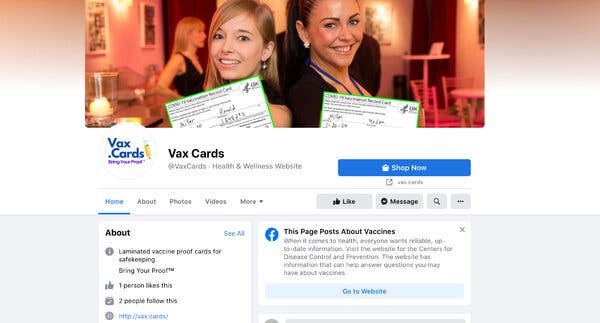
Online stores offering counterfeit or stolen vaccine cards have mushroomed in recent weeks, according to Saoud Khalifah, the founder of FakeSpot, which offers tools to detect fake listings and reviews online.
The efforts are far from hidden, with Facebook pages named “vax-cards” and eBay listings with “blank vaccine cards” openly hawking the items, Sheera Frenkel reports for The New York Times.
Last week, 45 state attorneys general banded together to call on Twitter, Shopify and eBay to stop the sale of false and stolen vaccine cards.
Facebook, Twitter, eBay, Shopify and Etsy said that the sale of fake vaccine cards violated their rules and that they were removing posts that advertised the items.
The Centers for Disease Control and Prevention introduced the vaccination cards in December, describing them as the “simplest” way to keep track of Covid-19 shots. By January, sales of false vaccine cards started picking up, Mr. Khalifah said. Many people found the cards were easy to forge from samples available online. Authentic cards were also stolen by pharmacists from their workplaces and put up for sale, he said.
Many people who bought the cards were opposed to the Covid-19 vaccines, Mr. Khalifah said. In some anti-vaccine groups on Facebook, people have publicly boasted about getting the cards.
Other buyers want to use the cards to trick pharmacists into giving them a vaccine, Mr. Khalifah said. Because some of the vaccines are two-shot regimens, people can enter a false date for a first inoculation on the card, which makes it appear as if they need a second dose soon. Some pharmacies and state vaccination sites have prioritized people due for their second shots.
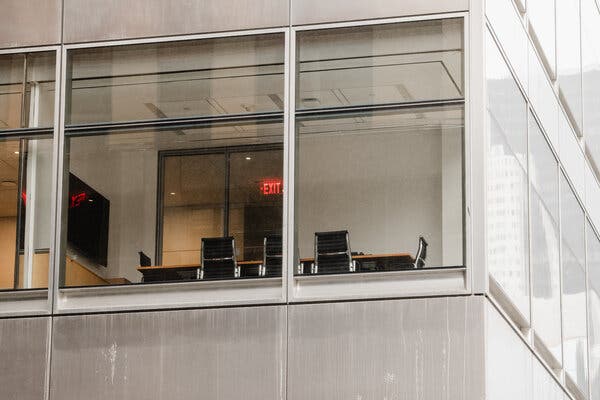
In only a year, the market value of office towers in Manhattan has plummeted 25 percent, according to city projections released on Wednesday.
Across the country, the vacancy rate for office buildings in city centers has steadily climbed over the past year to reach 16.4 percent, according to Cushman & Wakefield, the highest in about a decade. That number could climb further if companies keep giving up office space because of hybrid or fully remote work, Peter Eavis and Matthew Haag report for The New York Times.
So far, landlords like Boston Properties and SL Green have not suffered huge financial losses, having survived the past year by collecting rent from tenants locked into long leases — the average contract for office space runs about seven years.
But as leases come up for renewal, property owners could be left with scores of empty floors. At the same time, many new office buildings are under construction — 124 million square feet nationwide, or enough for roughly 700,000 workers. Those changes could drive down rents, which were touching new highs before the pandemic. And rents help determine assessments that are the basis for property tax bills.
Many big employers have already given notice to the owners of some prestigious buildings that they are leaving when their leases end. JPMorgan Chase, Ford Motor, Salesforce, Target and more are giving up expensive office space and others are considering doing so.
The stock prices of the big landlords, which are often structured as real estate investment trusts that pass almost all of their profit to investors, trade well below their previous highs. Shares of Boston Properties, one of the largest office landlords, are down 29 percent from the prepandemic high. SL Green, a major New York landlord, is 26 percent lower.
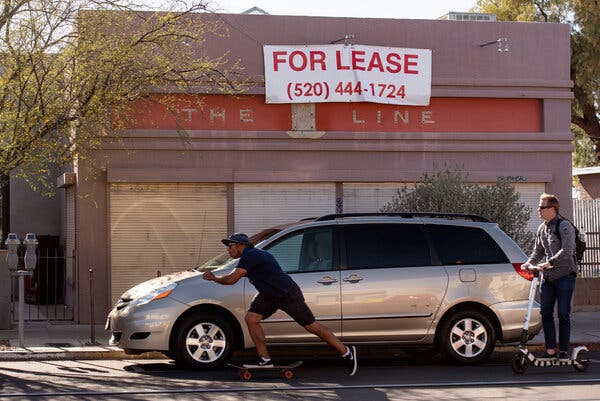
-
U.S. stock futures rose on Friday along with government bond yields after the Federal Reserve chair, Jerome Powell, reiterated his intention to keep supporting the economic recovery until it is complete.
-
The rollout of vaccinations meant the United States economy could probably reopen soon, but the recovery was still “uneven and incomplete,” Mr. Powell said at the International Monetary Fund annual conference on Thursday.
-
He pointed out that the economic burden of the pandemic was falling most heavily on low-income service workers who were least able to bear it. “I really want to finish the job and get back to a great economy,” Mr. Powell said.
-
The yield on 10-year Treasury notes jumped 5 basis points, or 0.05 percentage point, to 1.67 percent. The yield on 10-year government bonds rose across Europe, too.
Stocks, low volatility and oil prices
-
The S&P 500 index was set to open 0.1 percent higher and has risen 0.4 percent so far this week.
-
The relatively quiet week in the stock market has sent the VIX index, a measure of volatility, to its lowest level since February 2020. The index was at 17 points on Friday. In mid-March, as the pandemic shut down huge parts of the global economy, it spiked above 80.
-
European stock indexes were mixed on Friday, though the Stoxx Europe 600 was heading for its sixth straight week of gains. The DAX index in Germany rose 0.1 percent after data showed an unexpected drop in industrial production.
-
Oil prices rose slightly with futures of West Texas Intermediate, the U.S. crude benchmark, 0.2 percent higher to $59.70 a barrel.






